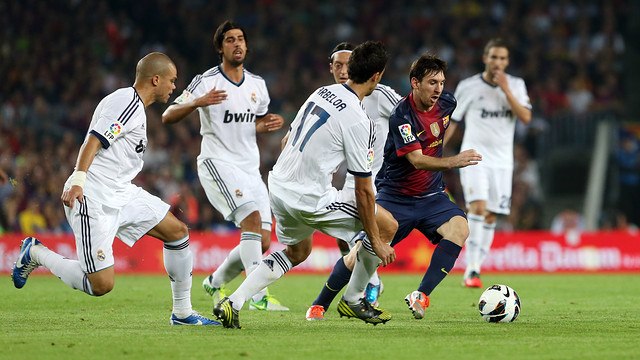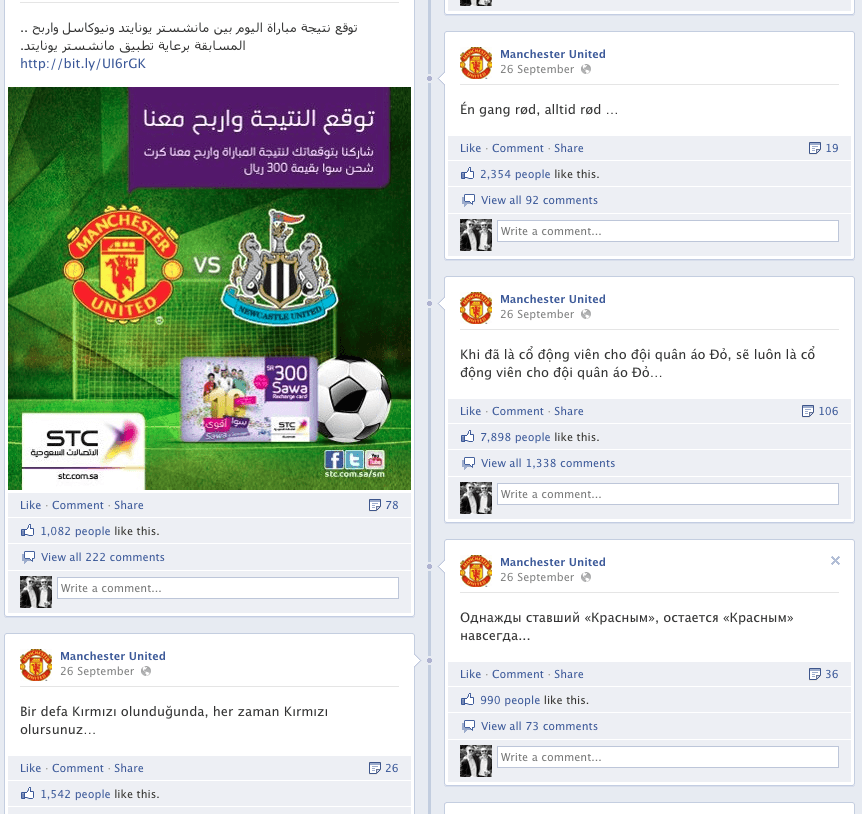The Do’s and Don’ts of Local Language Posting
An area within social which is taking up more conversations is how sports clubs, and even players, should be communicating with their fans using different languages. This is something that came up in the #smsportschat (which is worth keeping an eye on) as the Miami Hurricanes have a Spanish Twitter account.
In Europe this is more of a pressing issue than in most, not only with the proliferation of languages on the continent itself but also with the bigger clubs looking to connect with fans in Asia and South America. One of the reasons it came to my mind was in seeing the different ways clubs operate on Facebook.
For example, AC Milan and Barcelona post in both their native language and in English on almost every post. Thus they hit the majority of their targeted audience within one post without spamming people or making the page look confusing.
This can’t be said to be true when looking at both Man Utd and Chelsea. It could just have been that the other day was a bad day on the posting front but suddenly there were a multitude of posts in different languages which had been posted globally.
To me as a fan it looked messy. From a professional perspective we work on how it is best to contact different people on our pages. Shjould you just post globally or should it be done on a local level within that country?
Facebook gives you the means to publish posts by country, which you can select either one or any multiple, or even by city (which is sometimes useful for specific events or ticket offers). But you can also post by language which means you would be posting to all fans who have made that language their one of choice.
The one thing it doesn’t allow unfortunately, and hopefully this will change, is to select who it does not go to. So for example if you wanted to publish a post to everyone in the world except your Japanese followers as you want to post to them in their own language. Currently you would have to go through an select all of the countries except Japan, which is a bit of a pain to do lets be honest.
So what is the right way?
For my point of view you either work on a localising level if you have a number of countries or languages you want to communicate to or you post globally in one or two languages which are your main focus. The method of putting out half a dozen posts in different languages in different global posts will eventually drive people away from your page. That’s not something which will sit well with those controlling the resources you need.
The success of their strategy is there for all to see. They have a very engaged Facebook page which has over 35m fans. On Twitter they have 3 accounts; @FCBarcelona is the 3rd biggest sports account in the world with over 6.9m fans. They also have @FCBarcelona_Es (3.2m) and @FCBarcelona_Cat (2.3m) appearing in the top 40 (source: Social Bakers).
As Pasi has said, on Twitter it has been easier to set up different accounts that concentrate on different languages. This allows the main account to focus on the a more global strategy, provide great content and extend their follower base.
For the bigger clubs and leagues this is something that they have to decide upon as the emerging markets are the ones they are all targeting (South America and Asia). The technology will change and hopefully make it easier to do so but it is not going to happen overnight.
About author
You might also like
SPORTEL 2021: Day One Recap
This year’s prestigious SPORTEL convention kicked off in sunny Monaco today, welcoming a host of familiar faces as well as plenty of new ones. Doors opened at 8:30am with businesses
Six Founding Riders Set To Bring The Vision Of The UCI Track Champions League To Life
Olympic Champions, UCI World Champions and World Record holders join the new track cycling competition debuting in November 2021 The UCI Track Champions League is delighted to announce that six
Sports related spending to soar this summer as pre-pandemic life resumes
New insights from eBay Ads UK reveal the potential for brands to engage with an excited but nervous nation as sports events get back on track As pubs and indoor










